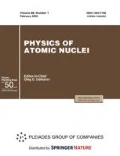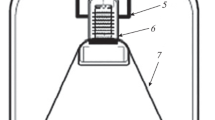Abstract
By accurate measurement of components and energy spectrum in the knee region, problem of origin of cosmic ray can be solved. In one extensive air shower (EAS), high energy hadrons, which constitute the EAS skeleton as G.T. Zatsepin called it, carry important information for multi-parameter correlation studies. The nuclear reaction between hadrons and matter in the surrounding environment produces a large number of evaporation neutrons, moderating to thermal neutrons. At the beginning of the 21th century, a new technology, electron–neutron detector (EN-detector) was designed at Institute for Nuclear Research of Russian Academy of Science (INR RAS), and the PRImary Spectrum Measurement Array (PRISMA) project was proposed to reinforce array capability of cosmic ray composition separation and then improve measurement accuracy of cosmic ray components and energy spectrum. Besides, EN-detectors can be used for continuous environmental thermal neutron flux monitoring and its variation study is needed not only for EAS experiment background estimation but also for geophysical applications (e.g., earthquakes, thunderstorms, radioactive aerosol control, etc.) and solar activity study (e.g., solar flares, Forbush effects, etc.). Under the Chinese–Russian cooperation, we put forward to build so called EN-Detector Array (ENDA) at high altitude in China. At YangBaJing Hybrid Array (YBJHA, 4300 m a.s.l.) and at Large High Altitude Air Shower Observatory (LHAASO, 4410 m a.s.l.), two clusters of ENDA were built individually and all have obtained coincident events with the local arrays. In the near future, we plan to extend ENDA to ENDA-64 with array area of 1000 m\({}^{2}\) inside LHAASO to study the knee region of the light components (H and He). After it, ENDA will be extended up to 400 detectors with array area of 10 000 m\({}^{2}\) to extend the energy range up to 300 PeV.





Similar content being viewed by others
REFERENCES
T. Antoni et al. (KASKADE Collab.), Astropart. Phys. 24, 1 (2005).
M. Amenomori et al. (Tibet AS\(\gamma\) Collab.), Phys. Lett. B 632, 58 (2006).
B. Bartoli et al. (AGRO-YBJ Collab., LHAASO Collab.), Phys. Rev. D 92, 092005 (2015).
Yu. V. Stenkin and J. F. Valdés-Galicia, Mod. Phys. Lett. A 17, 1745 (2002).
Yu. V. Stenkin, Nucl. Phys. B Proc. Suppl. 196, 293 (2009).
Yu. V. Stenkin, V. V. Alekseenko, D. M. Gromushkin, Y. Liu, X.-H. Ma, and J. Zhao, Chin. Phys. C 37, 015001 (2013).
Yu. V. Stenkin and J. F. Valdés-Galicia, in Proceedings of the 27th International Cosmic Ray Conference, Hamburg, 2001, p. 1453.
Yu. V. Stenkin, D. D. Djappuev, and J. F. Valdés-Galicia, Phys. At. Nucl. 70, 1088 (2007).
Yu. V. Stenkin, Nucl. Phys. B Proc. Suppl. 175–176, 326 (2008).
B. D’Ettorre Piazzoli, in Proceedings of the 32nd International Cosmic Ray Conference, Beijing, 2011, Vol. 12, p. 93.
B. Bartoli, P. Bernardini, X. J. Bi, Z. Cao, S. Catalanotti, S. Z. Chen, T. L. Chen, S. W. Cui, B. Z. Dai, A. D’Amone, Danzengluobu, I. De Mitri, B. D’Ettorre Piazzoli, T. Di Girolamo, G. Di Sciascio, C. F. Feng, et al., Astropart. Phys. 81, 49 (2016).
Y. Stenkin, V. Alekseenko, Z. Cai, Z. Cao, C. Cattaneo, S. Cui, E. Giroletti, D. Gromushkin, C. Guo, X. Guo, et al., Pure Appl. Geophys. 174, 2763 (2017).
Y. Stenkin, V. Alekseenko, Z. Y. Cai, Z. Cao, C. Cattaneo, S. W. Cui, P. Firstov, E. Giroletti, X. Guo, H. He, Y. Liu, X. Ma, O. Shchegolev, P. Vallania, C. Vigorito, Y. Yanin, and J. Zhao, J. Environ. Radioact. 208–209, 105981 (2019).
B. B. Li, V. V. Alekseenko, S.-W. Cui, T.-L. Chen, Dangzengluobu, S.-H. Feng, Q. Gao, Y. Liu, Q.-C. Huang, Y.-Y. He, M.-Y. Liu, X.-H. Ma, E. I. Pozdnyakov, O. B. Shchegolev, F. Z. Shen, Yu. V. Stenkin, et al., J. Instrum. 12, P12028 (2017).
Z. Wang, Y. Q. Guo, H. Cai, J. F. Chang, T. L. Chen, Danzengluobu, Y. L. Feng, Q. Gao, Q. B. Gou, Y. Y. Guo, C. Hou, H. B. Hu, Labaciren, C. Liu, H. J. Li, J. Liu, et al., Exp. Astron. 45, 363 (2018).
Liu Cheng, Xiao-Jun Bi, Tian-Lu Chen, Wen-Yi Chen, Shu-Wang Cui, Danzengluobu, Lin-Kai Ding, Xiao-Hong Ding, Cun-Feng Feng, Zhao-Yang Feng, Zhen-Yong Feng, Quan-Bu Gou, Hong-Wei Guo, Yi-Qing Guo, Hui-Hai He, Zheng-Tao Hou, et al., Chin. Phys. C 37, 026001 (2013).
X. Ma, J. He, Y. Zhang, Y. Feng, Y. Guo, H. Hu, C. Liu, S.-W. Cui, B.-B. Li, S. Liu, C. Shi, Y. Liu, V. Alekseenko, K. Levochkin, V. Rulev, O. Shchegolev, et al., in Proceedings of the 36th International Cosmic Ray Conference, Madison, 2019, ID 345.
M.-Y. Liu, V. Alekseenko, S.-W. Cui, T.-L. Chen, Dangzengluobu, Q. Gao, D. Kuleshov, K. Levochkin, Y. Liu, B.-B. Li, X.-H. Ma, O. Shchegolev, C. Shi, Y. Stenkin, and V. Stepanov, Astrophys. Space Sci. 365, 123 (2020).
Z. Cao (LHAASO Collab.), Chin. Phys. C 34, 249 (2010).
H. He (for LHAASO Collab.), Radiat. Detect. Tech. Methods 2, 7 (2018).
S. Cui et al. (LHAASO Collab.), Astropart. Phys. 54, 86 (2014).
Y. Liu, Z. Cao, Y. Chen, S. W. Cui, H. H. He, X. T. Huang, X. H. Ma, Q. Yuan, and X. Zhang, Astrophys. J. 826, 63 (2016).
X. H. Ma, O. B. Shchegolev, and Yu. V. Stenkin, in Proceedings of the 36th International Cosmic Ray Conference, Madison, 2019, ID 431.
Yu. V. Stenkin and O. B. Shchegolev, Bull. Russ. Acad. Sci.: Phys. 81, 503 (2017).
ACKNOWLEDGMENTS
This work was supported in China by National Natural Science Foundation of China (NSFC) (nos. U2031103, 11905043, U1831208, U1831129, 11963004, 12047575), Everest Discipline Construction Plan of Tibet University, and Postdoctoral Science Foundation of China under the grant no. 2019M652357.
Author information
Authors and Affiliations
Corresponding author
Rights and permissions
About this article
Cite this article
Li, BB., Cui, SW., Shi, C. et al. Electron–Neutron Detector Array (ENDA). Phys. Atom. Nuclei 84, 941–946 (2021). https://doi.org/10.1134/S1063778821130202
Received:
Revised:
Accepted:
Published:
Issue Date:
DOI: https://doi.org/10.1134/S1063778821130202




